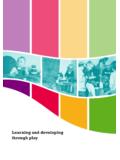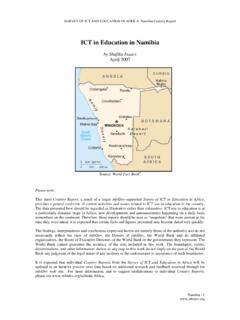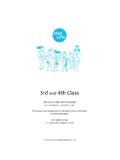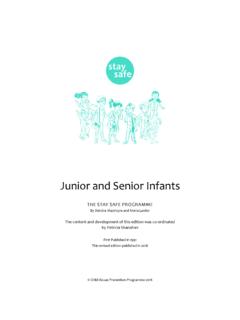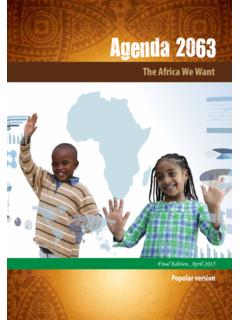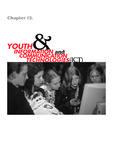Transcription of SPEEL Study of Pedagogical Effectiveness in Early …
1 SPEELS tudy of Pedagogical Effectivenessin Early LearningJanet Moyles, Si n Adams, Alison MusgroveSchool of Education Research and DevelopmentAnglia Polytechnic UniversityResearch Report RR363 RESEARCHR esearch Report No 363 SPEEL Study of Pedagogical Effectiveness in Early learning Janet Moyles, Si n Adams, Alison Musgrove School of Education Research and Development Anglia Polytechnic University The views expressed in this report are the authors' and do not necessarily reflect those of the Department for Education and Skills. Queen s Printer 2002. Published with the permission of DfES on behalf of the Controller of Her Majesty's Stationery Office.
2 Applications for reproduction should be made in writing to The Crown Copyright Unit, Her Majesty's Stationery Office, St Clements House, 2-16 Colegate, Norwich NR3 1BQ. ISBN 1 84185 765 3 June 2002 i CONTENTS page Table of Contents i. List of diagrams, figures and tables ii. Glossary iv. Section 1 Introduction and background 1 Section 2 Research design and methodology 9 Section 3 Analysis of the Data and source of Framework statements 24 Section 4 The Framework with exemplification for practitioners 48 Section 5 The Validation of the Framework 74 Section 6 The Literature Review 102 Section 7 Findings, Discussion and Recommendations 129 Section 8 References 139 Appendix A Interview Schedules: Practitioners and Managers/Heads (Layer 1) 149 Appendix B Interview Schedules: Managers/Head-teachers (Layers 2 and 3) 153 Appendix C Reflective Dialogues: Concept paper.
3 Introduction to Researchers. RD process information for practitioners. 160 Appendix D Early analysis: Practice level detailed statements 168 Appendix E Parent Questionnaire (Layer 2) 172 ii LIST OF DIAGRAMS, FIGURES and TABLES page Diagram A SPEEL Framework Model 4 Figure 1 Key Term Descriptor for Pedagogy 5 Figure 2 Key Term Descriptor for Practice 5 Figure 3 Key Term Descriptor for Principles 5 Figure 4 Key Term Descriptor for Professional Dimensions 5 Figure 5 Key Term Descriptor for Effectiveness 8 Figure 6 Representation of the research design and conduct 11 Figure 7 Practice Level Overview Chart (January 2001)
4 26 Figure 8 4Ps Model of Early Years Pedagogy 28 Figure 9 Detailed analysis of Collaboration from Layer 1 transcripts 29 Figure 10 Practice Level showing data reduction process 31 Figure 11 Example of Nud*Ist generated nodes for analysis (Layer 1) 32 Figure 12 Data Reduction Collaboration 33 Figure 13 Penultimate version of Practice Level Key Statements 34 Figure 14 Statements from initial Framework used within Layer 2 Heads /Managers Interviews 36 Figure 15 Reduced 3Ps Model 38 Figure 16 Conceptualising and articulating young children s thinking skills 44 Figure 17 Triangulation of Methods 77 Figure 18 Two example Case Studies from SPEEL Project 81 Figure 19 Triangulation through data collection 105 Figure 20 Moyles and Suschitzky's Planning.
5 Evaluation and Assessment Model 113 Table 1a Background of EAG 6 Table 2a Potential types of providers 10 Table 2b Authorities involved in the SPEEL research 12 Table 2c Analysis of LA personnel criteria for selection of settings 12 Table 2d 74 settings identified for effective practice by LA/Partnership personnel 13 Table 2e Data on the sample of 27 effective settings involved in SPEEL research 14 Table 2f Biographical details of practitioners 16 Table 2g Socio-economic background of children/families 18 Table 2h Percentage of ethnic-minority children across three layers 18 Table 2i Type of accommodation by setting 19 Table 2j Documentation gathered from 27 settings 23 Table 3a Parents response to 39 Table 3b Activities observed over Layers 2 and 3 46 Table 5a Response to web-based feedback and evaluation 80 Table 5b Chart showing sources of Key Statements in final Framework 93 iii page Graph 1 Average of all parents responses to Questionnaire 40 Graph 2 Female/male parents responses compared 41 Graph 3 Married/partnered parents response compared to single parents 41 Graph 4 Overall parents responses compared with those of minority ethnic parents 42 iv GLOSSARY Adult-led
6 Activities: adult decides what the child does; Area of Focus: each of the 3 main elements of the Framework, each of which is further sub-divided into 3 parts Articulate: ability to talk with confidence about practice and its underpinning beliefs, values and understandings Child-initiated activities: child decides what activities to do Curriculum: everything the child experiences in the setting planned and unplanned CGFS: Curriculum guidance for the foundation stage Definition: descriptor for particular terms used in the research Development: general pattern in the way that child functions and matures (physical, linguistic.)
7 Social/emotional areas and cognitive areas) Developmentally Appropriate: implies curriculum is congruent with child's developmental levels Dispositions to learning : an approach to learning typified by curiosity, creativity or independence EAG: Expert Advisory Group Early years experts in range of child related areas Early Years (EY): The Foundation Stage for children aged between 3 and 5+ years EPEY Effective Pedagogy in the Early Years Project Framework: overall synthesis of 129 Key Statements representing the core competences in effective Early years pedagogy Interaction: ways in which practitioners communicate (verbal and non-verbal) to adults and children Teaching: ranging from specific transmission of knowledge to change behaviour or supporting children's learning , sometimes through play ICT: Information and Communications Technology Key Statements: list of non-hierarchical statements of competence [in effective Early years pedagogy) under 3 headings (Areas of focus) within Practice, Principles and Professional Dimensions Layer 1 3: division within SPEEL project involving examining proportion of settings within each of three terms learning environment.]
8 Includes the physical environment of the setting and the nature of the learning atmosphere within the setting informed by values, beliefs and understanding of the practitioner Manager/headteachers: managers of playgroups or nursery units, heads of centres,headteachers of schools Pedagogy: based in practice, includes management and organisational factors and demands specific set of knowledge, skills, techniques and values which inform the education and care of learners. See definition in Section 1 Practice: all that the pedagogue does within the teaching and learning context. See definition in Section 1 Practitioners: adults who work with children in the settings v Principles: underpin/ inform practice and are based upon informed knowledge and theories of Early childhood education.
9 See definition in Section 1 RD: reflective dialogue Reflective Dialogue: focused interview guided by researcher based on practitioner's selection and control of video episodes taken in settings. See more comprehensive definition of RD method in Appendix Ci SEN: Special Educational Needs Settings: school reception class or unit; nursery class or school; pre-school playgroup, day nursery or childminder; combined centre Skills: small units of behaviour that are easily observed SPEEL Study of Pedagogical Effectiveness in Early learning 1 SECTION 1 Introduction 2 SECTION ONE Introduction This section introduces the final report for the Study of Pedagogical Effectiveness in Early learning ( SPEEL ) Project.
10 It gives some basic factual information about how the research has been conceptualised by those involved. It explores the language of the project and contains descriptors of the key terms used. The contribution of the various participants is outlined. Finally it outlines the aims, objectives and achievements of the research and indicates where adaptations were necessarily made to meet the expectations of settings and enable the research to be completed within the defined timescale. This ethnographic Study began on the 1st November 2000 and was completed on the 31st October 2001. The research has sought to identify the components of effective pedagogy which are embedded within the practices and thinking of those adults who work with 3- to 5-year-old children within the context of the new Foundation Stage (FS).












